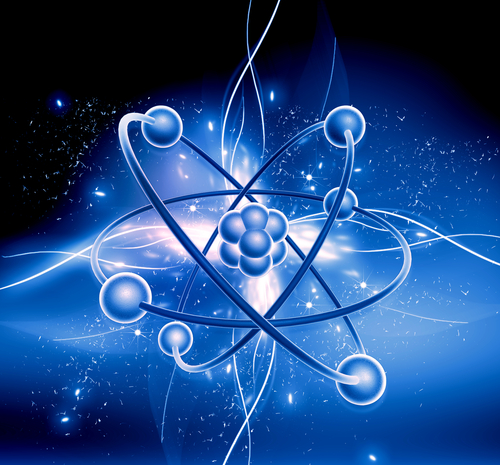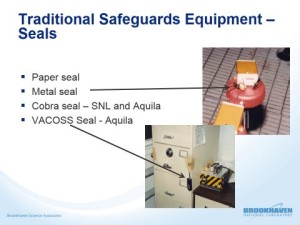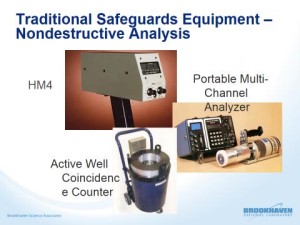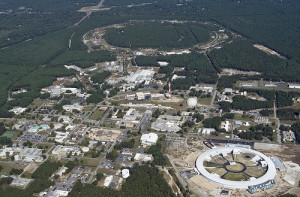
Building an Effective Nonproliferation Program: U.S. Support of IAEA Safeguards
To achieve our mutual goals of moving toward a world without nuclear weapons and expanding the peaceful use of nuclear energy globally, we must all give our financial, political, and technical support to a robust international safeguards regime. A growing international safeguards regime, capable of detecting diversion at known facilities and providing assurances regarding the absence of undeclared activities, is a condition for achieving disarmament and making the world safe for nuclear energy.
The United States is committed to providing the support that the IAEA needs through our Member State Support Program and the Department of Energy’s Next Generation Safeguards Initiative. These programs provide over $25 million per year in extra-budgetary and in-kind support to the Department of Safeguards.
–Secretary of Energy, Steven Chu, at the 2012 IAEA General Conference
A central pillar of international efforts to stem the spread of nuclear weapons is the International Atomic Energy Agency (IAEA) safeguards system. From the inception of the IAEA, the United States has supported the development and evolution of both the safeguards system itself and devices and systems approaches used by inspectors. The IAEA safeguards system comprises an extensive set of technical measures by which the IAEA Secretariat independently verifies the correctness and the completeness of the declarations made by States to the IAEA about their nuclear programs. From Iran to Syria, to the more than 190 other countries that accept IAEA safeguards, the IAEA safeguards system enhances international security, seeking to assure compliance with international nuclear agreements. The cornerstone of the global nonproliferation regime is the Treaty on the Non-proliferation of Nuclear Weapons (NPT). IAEA safeguards largely have evolved to ensure non-nuclear weapon state compliance with the NPT.
Because of the importance of the IAEA safeguards to international security and the facilitation of the peaceful uses of nuclear energy, the United States provides substantial assistance to the IAEA to improve the safeguards system. Much of this assistance is provided by US national laboratories and coordinated by the International Safeguards Support Office at Brookhaven National Laboratory. This article discusses the behind-the-scenes work of a network of U.S. Department of Energy national laboratories that support the IAEA and international safeguards.
The safeguards system is a complex verification system built on the reporting by States of their nuclear material inventories and on-site inspections conducted by the IAEA. The goal of the system is to enable the IAEA to verify that these accounts are “correct” – everything has been reported correctly – and “complete” – everything that should be reported has been – and, thus, the accounts represent the facts on the ground: “all present and accounted for.” The IAEA’s ability to do this with high confidence and to detect discrepancies in a timely manner is intended to deter States from diverting nuclear material and to sound the alarm promptly if States are not deterred.
An intrinsic tension exists between the pursuit of nuclear energy and the effort to prevent the illicit development of nuclear weapons – elements of the nuclear fuel cycle and nuclear material used to produce energy can also be used to produce nuclear weapons. For example, the enriched uranium that fuels most power reactors is produced in facilities that have the capability to produce uranium at the enrichment levels needed for nuclear weapons. Reprocessing of used reactor fuel assemblies proceeds in reprocessing plants whose output is separated plutonium in chemical and physical forms that are somewhat easily converted into the forms needed for nuclear weapons. Consequently, uranium enrichment plants and reprocessing plants are regarded as sensitive nuclear facilities.
This nuclear conundrum – the ability to use energy released from the atom as a weapon of war or as a tool for obtaining seemingly unbounded energy for powering homes, industry and development – was recognized at the dawn of the nuclear age. IAEA safeguards endeavor to make this conundrum manageable. On the one hand, IAEA safeguards can deter diversion of nuclear material from peaceful programs to nuclear weapon programs.

On the other hand, a positive conclusion by the IAEA of non-diversion can provide assurances to all countries in order to reduce regional and international tensions. The IAEA’s assurances allow States to engage in nuclear cooperation in medicine, agriculture and power with confidence that the materials and technology they supply will be used only for peaceful purposes. Thus, the IAEA safeguards system is intended to encourage peaceful uses of nuclear energy and, at the same time, inhibit nuclear proliferation.1
IAEA safeguards measures are diverse. For example, seals allow the IAEA to monitor access to States’ material or their own inspectors’ supplies while inspectors are absent from a facility. Seals are applied to material stores, reactor hatches and office cabinets where inspection equipment is stored. Seals are tamper indicating devices, meaning that if broken they indicate that an area has been accessed; they do not prevent access. Surveillance cameras are used in conjunction with seals to provide additional assurance of the lack of movement of materials within a facility or to verify that movements are related to scheduled operations. The foundation of nuclear material accountancy is a variety of destructive and nondestructive analysis techniques. These accountancy techniques provide qualitative and quantitative information regarding the composition of nuclear materials at a facility.
The IAEA Safeguards System has evolved over the past decades in response to new challenges. Traditionally, international safeguards were focused on inspections, nuclear material accountancy, and nuclear material measurements. After the first Gulf War in 1991, the IAEA Member States recognized the importance of enabling the IAEA to detect undeclared activities as well as confirm non-diversion of declared nuclear material.

In 1993, the Member States began a program called 93+2, to enhance the IAEA’s safeguards capabilities and authorities. The results of this effort were a broad new set of inspection rights and techniques for the IAEA codified in a new legally binding document, the Additional Protocol to the Member State/IAEA Safeguards Agreement, and a host of new safeguards techniques.
The verification activities of the IAEA safeguards system would not be possible without international political and technical support over the decades to enhance the system, its technology and the training of its personnel and to accept the application of safeguards. Because of the intrusive nature of international safeguards, international political support for their use has been vital. Article III of the NPT lays out the obligation for States to accept international inspectors visiting their nuclear facilities. These inspections may take place on a periodic or even unannounced basis to deploy cameras, seals and measurement equipment to verify States’ declarations. This political support has been facilitated by a careful balance that is struck between the intrusiveness of the safeguards and their technical necessity to ensure verification is effective.
The IAEA’s budget (including the budget provided for international safeguards), is approved by its Member States. While all Member States value the IAEA’s nonproliferation role, some have economic concerns and programmatic interests that result in the IAEA’s safeguards budget being constrained to a level that is widely considered lower than necessary to fully carry out its mission. The IAEA’s 2014-2015 budget includes “unfunded activities” the IAEA is required to undertake that are not funded due to higher priorities. Because of its budgetary situation, the IAEA requires assistance from Member State Support Programs in order to ensure it has the tools and skilled manpower that it needs. This extra budgetary support is in excess of $30 million per year of which the U.S. provides roughly half.
The United States Support Program (USSP) was established in January 1977 to respond to urgent needs of the IAEA Department of Safeguards more quickly than could be met through the IAEA’s administrative procedures. Although it was originally intended as a short-term program, the program has continued because it has been successful in transferring technology from the U.S. national laboratories and commercial equipment suppliers.2 The USSP is supported by a network of national laboratories and private companies that perform the work requested by the IAEA and approved by the United States Government. The requests have included nondestructive and destructive analysis instrumentation and techniques, procedures and training, system studies, information technology, containment and surveillance, and management support. In addition, the USSP sponsors a small number of administrative tasks, involving subjects such as technical writing and quality assurance. The USSP assists the IAEA with three types of human resources support. First, the USSP provides cost-free experts (CFEs) to work for the IAEA Department of Safeguards on specific projects for two or more years. The CFEs are extra-budgetary positions where the salary and benefits are reimbursed by the United States. The USSP also provides the Safeguards Department with Junior Professional Officers (JPOs), who are given entry level positions to perform basic, yet essential, work and gain valuable professional and technical experience. Finally, the USSP sponsors a number of shorter-term consultants. Typically about 100 USSP tasks are active at any given time.
Since 1977, the USSP has contributed funding in excess of $300 million and has funded over 1200 tasks.3 The USSP has provided significant human resources support through 188 CFEs and 25 JPOs representing an accumulated 688 man-years of effort. The USSP largely draws its funding from the Program on Technical Assistance to IAEA Safeguards (POTAS) which is funded through an Act of Congress under the Nonproliferation, Anti-Terrorism, Demining and Related Programs (NADR) account of the U.S. Department of State. The NADR account includes the U.S. extra budgetary funding, called the U.S. Voluntary Contribution (USVC) to the IAEA. The USVC includes funding for safeguards, technical cooperation, nuclear safety and nuclear security. In addition to POTAS, the USVC provides funding for the analysis of environmental samples, commercially available safeguards equipment, infrastructure improvement projects, CFEs and JPOs in the non-safeguards departments of the IAEA, and other activities.
The USSP activities are sometimes complemented by funding through other U.S. programs, such as the State Department’s Nonproliferation and Disarmament Fund for special projects, and the National Nuclear Security Administration’s Next Generation Safeguards Initiative (NGSI). Over the years, the U.S. Department of Energy, the U.S. Nuclear Regulatory Commission, and the U.S. Department of Defense have also contributed in-kind support.
Brookhaven
The day-to-day management of the USSP occurs through the International Safeguards Project Office (ISPO) which is based at Brookhaven National Laboratory (BNL) and includes a liaison office in Vienna, Austria, in the IAEA section of the U.S. Mission to International Organizations in Vienna (UNVIE). Brookhaven offers a unique open national laboratory campus outside of New York City with a 60-year history of science-based work related to U.S. arms control and nonproliferation goals. Brookhaven’s distinguished reputation in international safeguards precedes the establishment of the USSP.
One of ten national laboratories overseen and primarily funded by the Office of Science of the U.S. Department of Energy (DOE), Brookhaven National Laboratory conducts research in the physical, biomedical, and environmental sciences, as well as in energy technologies and national security. Brookhaven also builds and operates major scientific facilities available to university, industry and government researchers. Brookhaven is operated and managed for DOE’s Office of Science by Brookhaven Science Associates, a limited-liability company founded by the Research Foundation of the State University of New York on behalf of Stony Brook University, the largest academic user of Laboratory facilities, and Battelle, a nonprofit, applied science and technology organization.
In the 1960s, the Atomic Energy Commission selected Brookhaven to develop international safeguards principles. Brookhaven’s Technical Support Organization (TSO) became the home for many technical experts who developed their own reputations in the field through domestic safeguards activities with the U.S. Nuclear Regulatory Commission, AEC, DOE, tours of duty with the IAEA, and work on international safeguards projects funded by U.S. government agencies. It was Dr. Herbert Kouts, then the head of TSO, who originally proposed the concept of the USSP to U.S. government contacts in the mid-1970s.
In the early years of the USSP, BNL scientists and engineers designed a hand-held device called the Portable Multi-channel Analyzer that was eventually deployed by the IAEA for simple nuclear material measurements. This instrument became the workhorse for IAEA safeguards for many years until recently when it was replaced by more modern, advanced instruments. Recently, BNL experts have become involved in NNSA’s NGSI and assist the IAEA with technology development, concepts and approaches, policy, human capital development projects, and outreach to other Member States. According to Dr. Doon Gibbs, Brookhaven’s Laboratory Director, “Support for the IAEA safeguards system is one of the most important activities the lab pursues. We are a science laboratory with a long tradition of supporting national security efforts, and we are very proud of the work we have done in this area for decades.”

The central campus of Brookhaven National Laboratory. The National Synchrotron Light Source II, under construction at the time of this photo, is at bottom, right. The 3.8-kilometer circumference ring of the Relativistic Heavy Ion Collider can be seen in the distance at the top of the frame.
Over the last 15 years, BNL has become a safeguards training center, presenting courses for IAEA inspectors and Member States. BNL made use of its expertise in reactor design to develop a course on Design Information Verification of Research Reactors. This course teaches inspectors the safeguards significant attributes of research reactors and provides field exercises to help them practice associated skills. From about 1995 to 2001, the course was held at BNL and used its research reactors for facility tours. After a hiatus, the course was resurrected as a joint project with the Belgian Support Program, making use of expertise from BNL and facilities in Mol, Belgium. BNL won the honor of conducting a course on Additional Protocol/ Complementary Access4 for IAEA inspectors and has delivered the training at BNL since 2006. More recently, this training has been redesigned for delivery to IAEA Member States to teach them their responsibilities under the Additional Protocol. Brookhaven’s open campus makes it an excellent venue to host IAEA staff members and officials from other countries for training activities.

In addition, under the NGSI, Brookhaven has offered a course for the past five years that is intended to encourage qualified American and international students to enter the fields of safeguards and nonproliferation. The three-week course “Nuclear Non-proliferation, Safeguards and Security in the 21st Century,” is designed to give students a sound understanding of the foundations of the nuclear nonproliferation regime, the IAEA safeguards system, and U.S. efforts to meet emerging nuclear proliferation threats. In addition to lectures, the course includes exercises and demonstrations that take advantage of Brookhaven’s unique facilities. Above all, the course aims to give participants the knowledge, analytic tools, and motivation to contribute to improvement of the international nonproliferation regime.
In recent years, the USSP sponsored many tasks designed to assist the Agency in implementing the Additional Protocol, including programs in environmental monitoring, remote monitoring, and information technology. For the IAEA’s remote monitoring program, the USSP funded field trials for testing communication technologies such as telephone, Internet, and satellite. In addition, three engineers were sponsored as CFEs to help the IAEA develop its remote monitoring program, which is now operating effectively. Similar assistance was provided to help the IAEA establish the open source information collection and analysis program. Field trials and training were conducted for environmental sampling and, as a result, the IAEA was able to quickly implement its environmental sampling program. The USSP has traditionally provided significant support in enhancing the non-destructive analysis (NDA)5 and containment/ surveillance capabilities6 of the IAEA.
ISPO works with a network of national laboratories and numerous companies to meet the challenges facing the IAEA Department of Safeguards. For example, Los Alamos National Laboratory develops equipment and provides training in nondestructive analysis principles and implementation. Argonne National Laboratory provides training in export controls. Sandia National Laboratories has expertise in containment/surveillance, remote monitoring, and vulnerability assessments. Lawrence Livermore National Laboratory provides support in open source information and environmental sampling. Oak Ridge National Laboratory assists the IAEA with safeguards of enrichment technology. Companies working with ISPO include Aquila Technologies Group, Canberra Industries, and URS. The list of suppliers is long; the USSP is a national team effort.
“The United States Support Programme has played a key role through its R&D and implementation support activities in ensuring the IAEA safeguards system is able to continue to provide credible assurances that States are honouring their safeguards obligations, at a time of increasing verification challenges and resource limitations,” according to Jill Cooley, the IAEA’s Director for Concepts and Planning. The IAEA outlines its objectives in short-term, medium-term and long-term strategic and research and development plans. Its technical needs are documented in its biennial Development and Implementation Support Program.7
When the USSP was established, the U.S. government expected its $2.6 million investment to solve all the needs of the Department of Safeguards. In reality, the Department of Safeguards’ workload and need for support has increased as national interests in nuclear technology increase. In addition, as technology advances, so does the IAEA’s and Member States’ desire for better measurements and analysis. The Development and Implementation Support Program of the IAEA lists 24 projects for which the IAEA needs extra budgetary assistance. Despite having access to the extra budgetary resources of 21 Member State Support Programs, the IAEA’s technical needs outpace its resources.
Figure 1: U.S. Voluntary Contribution to the International Atomic Energy Agency
Because of the strong U.S. support for IAEA safeguards, the USVC portion for safeguards has increased substantially over the years. For example, Figure 1 shows an increase in total funding for the program over the past decade of 60%. At the same time, increasing security and economic concerns compete with and draw resources away from the IAEA and MSSPs. It is not clear in the current environment of decreasing budgets whether and how the IAEA can achieve the right balance in safeguard’s technical effectiveness and cost efficiencies. The USSP has been able to maintain its high level of support to the IAEA Department of Safeguards through increased efficiency by the USSP, prioritization of needs, and increases in other areas of the IAEA budget, such as direct support to large infrastructure projects.
The IAEA provides an important service to the world community in deterring the spread of nuclear weapons and enabling access for its Member States to the benefits of nuclear technology. The USSP, and other Member State Support Programs sponsored by countries around the globe, provide the IAEA with financial and technical resources that help it in its mission. Without these resources, the IAEA would not have obtained the advanced tools and developed the capabilities it needs to verify Member States’ compliance with the Nuclear Nonproliferation Treaty. Brookhaven National Laboratory is proud of its role in managing ISPO. There is still much work to be done and new challenges ahead. Brookhaven looks forward to assisting the U.S. government in future efforts to strengthen the effectiveness and improve the efficiency of safeguards.
Warren Stern is Senior Advisor in Brookhaven National Laboratory’s Nonproliferation and National Security Department. In 2010, he was appointed by President Obama to lead the Domestic Nuclear Detection Office at DHS and before that, Head of the IAEA’s Incident and Emergency Centre. He has also held a number of leadership positions at the U.S .Department of State, Arms Control and Disarmament Agency and CIA.
Susan Pepper is the Deputy Chair of the Nonproliferation and National Security Department at Brookhaven National Laboratory. She has been the Coordinator of the U.S. Support Program to IAEA Safeguards since 1996 and she was the Head of the International Safeguards Project Office at BNL from 1999 to 2011.
Satellite imagery has long served as a tool for observing on-the-ground activity worldwide, and offers especially valuable insights into the operation, development, and physical features related to nuclear technology.
This report outlines a framework relying on “Cooperative Technical Means” for effective arms control verification based on remote sensing, avoiding on-site inspections but maintaining a level of transparency that allows for immediate detection of changes in nuclear posture or a significant build-up above agreed limits.
The grant comes from the Carnegie Corporation of New York (CCNY) to investigate, alongside The British American Security Information Council (BASIC), the associated impact on nuclear stability.
Satellite imagery of RAF Lakenheath reveals new construction of a security perimeter around ten protective aircraft shelters in the designated nuclear area, the latest measure in a series of upgrades as the base prepares for the ability to store U.S. nuclear weapons.